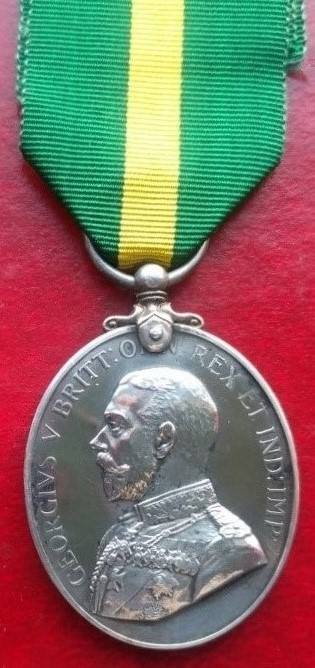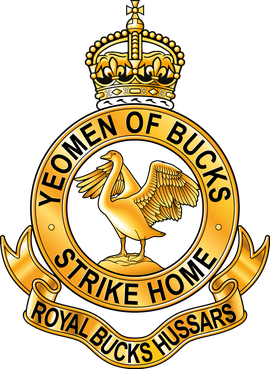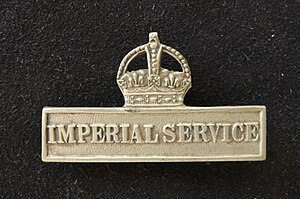
The Army Reserve is the active-duty volunteer reserve force of the British Army. It is separate from the Regular Reserve whose members are ex-Regular personnel who retain a statutory liability for service. Descended from the Territorial Force, the Army Reserve was known as the Territorial Army (TA) from 1921 to 1967 and again from 1979 to 2014, and the Territorial and Army Volunteer Reserve (TAVR) from 1967 to 1979.

The 56th (London) Infantry Division was a Territorial Army infantry division of the British Army, which served under several different titles and designations. The division served in the trenches of the Western Front during the First World War. Demobilised after the war, the division was reformed in 1920 and saw active service again in the Second World War in Tunisia and Italy. The division was again disbanded in 1946 and reformed first as an armoured formation and then as an infantry division before final disbandment in 1961.
The Isle of Man Volunteers was a nominal battalion of Britain's Volunteer Force formed during the 1860s and disbanded in 1920. Its service companies saw active service in the Second Boer War and World War I. During its existence, the battalion had the distinction of being the only representative of the Isle of Man in the British Army, and the last Volunteer Force unit.

The Territorial Force Efficiency Medal was a United Kingdom award for long service in the Territorial Force between 1908 and 1921.

The Royal Buckinghamshire Yeomanry is an Operational Hygiene Squadron of the Royal Logistic Corps, originally formed as cavalry in 1794, and has also served in artillery and signals roles. The lineage is continued by 710 Operational Hygiene Squadron, Royal Logistic Corps.

The East Midland Brigade was an infantry brigade of the Territorial Force, part of the British Army, that was raised in 1908. As the name suggests, it commanded infantry battalions recruited in the East Midlands of England: Bedfordshire, Northamptonshire, Cambridgeshire and Hertfordshire. The brigade was an integral part of the East Anglian Division.

25th Cyclist Battalion was a bicycle battalion of the London Regiment of the British Army. The battalion was converted to a unit of the Royal Corps of Signals in 1922.
The Ayrshire Royal Horse Artillery was a Territorial Force Royal Horse Artillery battery that was formed in Ayrshire in 1908. It saw active service during the First World War in the Sinai and Palestine Campaign with the ANZAC Mounted Division from 1916 to 1918. It was disembodied after the end of the war and was not reconstituted in the post-war Territorial Force.
The Inverness-shire Royal Horse Artillery was a Territorial Force Royal Horse Artillery battery that was formed in Inverness-shire in 1908. It saw active service during the First World War in the Sinai and Palestine Campaign with the ANZAC Mounted Division from 1916 to 1918. A second line battery, 2/1st Inverness-shire RHA, served in the United Kingdom throughout the war. It was disembodied after the end of the war and was reconstituted as a Royal Field Artillery battery in 1920.

The Nottinghamshire Royal Horse Artillery was a Territorial Force Royal Horse Artillery battery that was formed in Nottinghamshire in 1908. It saw active service during the First World War in the Middle East – in the Senussi Campaign and the Sinai and Palestine Campaign – from 1915 to 1918. A second line battery, 2/1st Nottinghamshire RHA, served in the Mesopotamian Campaign in 1917 and 1918 as a Field Artillery battery. Post-war, it was reconstituted as a Royal Field Artillery battery.
The Black Watch Brigade was a Territorial Force infantry brigade of the British Army. Formed in 1908, it was not part of any division, instead being assigned to Coastal Defence duties in Scottish Command. It was dissolved in early 1915 as its constituent battalions were posted to other formations.
The South Wales Brigade was a Territorial Force infantry brigade of the British Army. Formed in 1908, it was not part of any division, instead serving as Army Troops, though attached to the Welsh Division in peacetime. It was dissolved in early 1915 as its constituent battalions were posted to other formations.

The Aberdeen Fortress Royal Engineers was a Scottish volunteer unit of the British Army formed in 1908. Its main role was defence of the Scottish coast, but it served on the Western Front during World War I. In the 1930s it was converted into an air defence unit, in which role it served in World War II.
The Essex (Fortress) Royal Engineers was a volunteer unit of Britain's Royal Engineers formed to defend the Essex coast. It served in this role in World War I and then converted to a searchlight regiment for air defence in World War II. The unit ended the war as a garrison infantry battalion. Its descendants continued to serve in the Territorial Army until 1955.

The 1st Orkney Artillery Volunteers (OAV) was a part-time unit of Britain's Royal Artillery formed in the Orkney Islands in 1860 as a response to a French invasion threat. The unit served as coast artillery until it was disbanded after World War I.
The 1st North Riding Artillery Volunteers was a part-time unit formed in the North Riding of Yorkshire in 1860 in response to an invasion scare. The unit later became part of the Territorial Force and served on the Western Front during World War I, while their successors served as anti-aircraft gunners in World War II.
The 22nd Battalion, London Regiment was an auxiliary unit of the British Army. Formed in 1908 from Volunteer units in the Surrey suburbs of London that dated back to 1860, it was part of the London Regiment in the Territorial Force (TF). Its battalions served on the Western Front and in Palestine during World War I. When the London Regiment was abolished in 1937 the unit reverted to the Queen's Royal Regiment and during World War II its battalions fought in North Africa, Tunisia, Italy and North West Europe. It was amalgamated with other battalions into the Queen's Regiment in 1961.
The 6th Battalion, Royal Scots, was a unit of Britain's part-time Territorial Force. Beginning as a Volunteer unit formed from teetotallers in the city of Edinburgh in 1867, it later became affiliated to the Royal Scots. During World War I it served in the Senussi Campaign and on the Western Front. Postwar it was converted into a medium artillery battery.
The 1st Inverness-shire Artillery Volunteers, later the Highland Artillery Volunteers, was a Scottish auxiliary unit of the British Army from 1860 to 1908. With its headquarters in Inverness, it was recruited for home defence from a number of shires in the northern Scottish Highlands. It later provided the basis for a number of Territorial Force units in the Highlands.
The Cumberland Artillery was a group of Volunteer artillery batteries formed in the county of Cumberland, England, in 1860. They became part of the Royal Garrison Artillery, and when the Territorial Force was created in 1908 they formed a Royal Field Artillery howitzer brigade for the East Lancashire Division. In World War I the brigade served at Gallipoli and in Egypt, then was broken up amongst the divisional artillery: its batteries fought on the Western Front for the rest of the war. In the 1920s the Cumberland Artillery batteries combined with the Westmorland and Cumberland Yeomanry to form a new field regiment of the Royal Artillery that saw considerable action in World War II.









